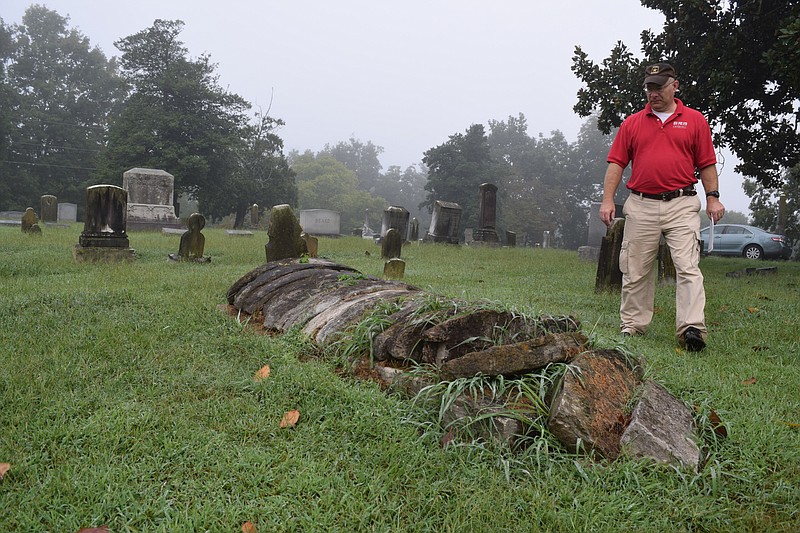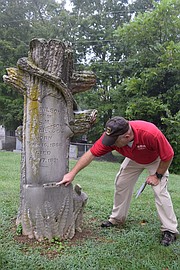To help
Contact the Tennessee Overhill Heritage Association in Etowah, Tenn., at info@tennessee overhill.com or call 423-263-7232 or 1-877-510-5765 to pass along information about any odd, unusual or mysterious graves and markers.
ATHENS, Tenn. - Some are majestic, grand monuments to the dead; others so simple they appear part of the natural earth.
In one, the deceased seems to call out from the grave.
The Tennessee Overhill Heritage Association in nearby Etowah, Tenn., is conducting a study of the "odd, unusual and mysterious" grave sites in the Tennessee counties of McMinn, Monroe and Polk in the Appalachian foothills. Officials are cataloguing them, searching out their histories, trying to learn their stories and urging maintenance of the final resting places.
"We've done our field work, [but] it's not completely over with," said Gerald Hodge, executive director of the association and leader of the project. He's working with Western Kentucky University intern Sydney Verajon, who got her bachelor's degree from Tennessee Wesleyan College.
"It's been an interesting project," Hodge said Friday morning as he walked through the wet grass at Cedar Grove Cemetery in Athens. "There are 667 known cemeteries in Polk, Monroe and McMinn counties."
He and Verajon put word out about what they were looking for in local papers, through social media and by word of mouth as they prowled the region's cemeteries. People reported with tips on where to go, he said.
The project so far has documented dozens of unusual graves. They are marked with stone, concrete and glass, marble, cast iron and materials as fragile as slate, with beautifully carved decorations and names. Many Woodmen of the World graves, most made to look like trunks of trees, stand at Cedar Grove and other graveyards in the three-county area.
"I focused on the time period beginning with the formation of the counties to around the 1940s, with the exception of one. That's the tombstone of Danny Roberts," Hodge said.
As he strolled through Cedar Grove Cemetery, Hodge scuffed through the turf to a coffin-shaped tomb, crumbling with age and believed to have belonged to a member of the post-Removal Cherokee or Creek tribes who remained behind after the Trail of Tears.
"This is the most unusual. This is called a 'grave house' for its construction," Hodge said, looking down on the tomb believed to have been built around 1840.
The elderly man buried there was chronicled in the Chattanooga Times in the 1920s when the site was looted by grave robbers. The article identified the occupant of the grave as "a famous Cherokee Indian chief," and noted a couple of pick axes and a shovel found nearby. The robbers stole the coffin from the grave and dragged it away.
Hodge said he's still working to identify the chief.
Ultimately, Hodge hopes the project gets the attention of families of the deceased whose tombs are eroding or are damaged.
He's visibly upset by evidence of continued vandalism of graves at Cedar Grove. Most cemeteries bear the scars of vandals and that makes Hodge mad, but he also worries about families losing their heritage and losing family grave markers to time.
Some have new markers erected in place of, or in addition to, older graves like that of Lillian Hutsell who died in Athens in 1929. A new marker next to the old reads, "She was the Roaring Twenties."
In Monroe County near Tellico Plains, the Roberts grave at Shady Grove Cemetery drew attention in the 1970s for the soldier's letter inscribed upon it.
At the top, it reads, "I want this put on a large tombstone at the head of my grave."
The letter chiseled into the stone reads, "To Whom It May Concern,
"I lived on this here climate for 20 years. The first 19 were full of excitement and pleasure. Then it happened. I got drafted to the army and sent to Vietnam to fight a useless war. With God's help I'll make it to heaven. I done spent my time in Hell. Take heed, dear friends, I died needlessly along with a lot of my comrades. But I did my best. This is a cruel world that we live in even though I consider myself the luckiest guy that ever lived because of you, my many dear friends and relatives, and because I had the greatest mom and dad in the world. Goodbye for now. We'll meet again on that great judgment morning. May God bless and keep all of us and bring everlasting peace."
Markers like these catch the eyes of passersby and preserve memories and history for their descendants through generations, Hodge said.
"If you don't preserve your history, you're doomed to repeat it," he said.
Contact staff writer Ben Benton at bbenton@timesfreepress.com or twitter.com/BenBenton or www.facebook.com/ben.benton1 or 423-757-6569.

